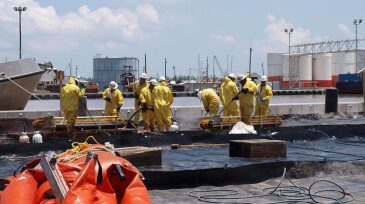Health
The National Institute for Occupational Safety and Health and its predecessor, the US Bureau of Mines, have significantly contributed to enhancing the safety of miners and to applying new technologies to the mining industry.
TechnipFMC diver Stuart Cowie shares his 17-year experience working as a saturation diver in the oil and gas industry and how to manage mental health and well-being during the often-isolating work demands.
This paper describes how a global energy technology company developed a mental health first aid program to provide workplace access to a trained mental health responder and how this initiative helps raise awareness of the importance of good mental health in the workplace.
-
Babies in Nigeria are at double the risk of dying before they reach a month old if mothers lived near the scene of an oil spill before conceiving, study shows.
-
The US Department of Labor’s Occupational Safety and Health Administration, which had ceased most programmed enforcement actions following Hurricane Harvey, resumed normal enforcement throughout Texas and Louisiana.
-
Workers who were likely exposed to dispersants while cleaning up the 2010 Deepwater Horizon oil spill experienced a range of health symptoms including cough and wheeze and skin and eye irritation, according to scientists at the National Institutes of Health (NIH).
-
While drug use is a problem among industrial workers nationwide, it raises particular concern in the oil patch as US production surges to record levels in what is already one of the nation’s most dangerous sectors.
-
Inhalation of crystalline silica dust is second only to asbestos as a hazard to construction workers. This video discusses important things to know.
-
The use of eye PPE among workers who sustain an eye injury in the workplace remains low. This study looked at workers with eye injuries and evaluated their characteristics and outcomes.
-
The authors of this paper aimed to estimate credibility intervals for the British occupational cancer burden to account for bias uncertainty, using a method adapted from Greenland’s Monte Carlo sensitivity analysis.
-
Shift work can interrupt circadian rhythms. A new study shows that exposure to certain types of light can improve alertness in shift workers.
-
Personal risk factors such as heat acclimation as well as environmental factors and high metabolic rate during work are the major determinants of heat-related illnesses.
-
Cases of lymphohematopoietic cancer from three petroleum industry cohorts, matched to controls from the respective cohort, were pooled into single study









